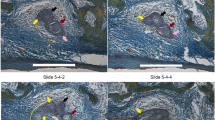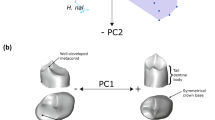Abstract
Late eruption of the permanent dentition was recently proposed as a shared anatomical feature of endemic African mammals (Afrotheria), with anecdotal reports indicating that it is also present in dasypodids (armadillos). In order to clarify this question, and address the possiblity that late eruption is shared by afrotherians and dasypodids, we quantified the eruption of permanent teeth in Dasypus, focusing on growth series of D. hybridus and D. novemcinctus. This genus is the only known xenarthran that retains two functional generations of teeth. Its adult dentition typically consists of eight upper and eight lower ever-growing (or euhypsodont) molariforms, with no premaxillary teeth. All but the posterior-most tooth are replaced, consistent with the identification of a single molar locus in each series. Comparison of dental replacement and skull metrics reveals that most specimens reach adult size with none or few erupted permanent teeth. This pattern of growth occurring prior to the full eruption of the dentition is similar to that observed in most afrotherians. The condition observed in Dasypus and many afrotherians differs from that of most other mammals, in which the permanent dentition erupts during (not after) growth, and is complete at or near the attainment of sexual maturity and adult body size. The suture closure sequence of basicranial and postcranial epiphyses does not correlate well with dental eruption. The basal phylogenetic position of the taxon within dasypodids suggests that diphyodonty and late dental replacement represent the condition of early xenarthrans. Additionally, the inferred reduction in the number of molars to a single locus and the multiplication of premolars represent rare features for any living mammal, but may represent apomorphic characters for Dasypus.




Similar content being viewed by others
References
Agnolin FL, Chimento NR (2011) Afrotherian affinities for endemic South American “ungulates.” Mammal Biol 76:101–108 doi:10.1016/j.mambio.2010.12.001
Asher RJ, Bennett N, Lehmann T (2009) The new framework for understanding placental mammal evolution. BioEssays 31:853–864
Asher RJ, Lehmann T (2008) Dental eruption in afrotherian mammals. BMC Biol 6:14
Asher RJ, Olbricht G (2009) Dental ontogeny in Macroscelides proboscideus (Afrotheria) and Erinaceus europaeus (Lipotyphla). J Mammal Evol 16:99–115
Ballowitz E (1892) Das Schmelzorgan der Edentaten, seine Ausbildung im Embryo und die Persistenz seines Keimrandes bei dem erwachsenen Thier. Archiv mikr Anat 40:133–156
Billet G, Martin T (2011) No evidence for an afrotherian-like delayed dental eruption in South American notoungulates. Naturwissenschaften 98:509–517
Castro MC (2009) Redescrição de um Dasypodini (Xenarthra, Cingulata) do Quaternário do Estado de São Paulo e considerações sobre o gênero Propraopus Ameghino, 1881. Masters Thesis, Universidade de São Paulo
Castro MC (2010) First occurence of deciduous teeth in Dasypus kappleri Krauss, 1862 and notes on the dentition of the genus. 9th Int Congr Vert Morphol, Punta del Este
Castro MC, Ciancio MR, Carlini AA (2010) Sobre la dentición de Dasypus (Dasypodidae, Cingulata, Xenarthra): morfología y posibles homologías. XXIII Jorn Argent Mastozool, Bahía Blanca
Ciancio MR, Vieytes EC, Castro MC, Carlini AA (2010) Estructura del esmalte en Dasypus (Xenarthra, Dasypodidae), consideraciones filogenéticas preliminares. XXIII Jorn Argent Mastozool, Bahía Blanca
Delsuc F, Vizcaíno SF, Douzery EJP (2004) Influence of Tertiary paleoenvironmental changes on the diversification of South American mammals: a relaxed molecular clock study within xenarthrans. BMC Evol Biol 4:1–13
Engelmann GF (1978) The logic of phylogenetic analysis and the phylogeny of the Xenarthra. PhD dissertation, Columbia University, New York
Gaudin TJ, Wible JR (2006) The phylogeny of living and extinct armadillos (Mammalia, Xenarthra, Cingulata): a craniodental analysis. In: Carrano MT, Gaudin TJ, Blob RW, Wible JR (eds) Amniote Paleobiology: Perspectives on the Evolution of Mammals, Birds and Reptiles. University of Chicago Press, Chicago, pp 153–198
Hallström BM, Kullberg M, Nilsson MA, Janke A (2007) Phylogenomic data analyses provide evidence that Xenarthra and Afrotheria are sister groups. Mol Biol Evol 24:2059–2068
Hensel R (1872) Beiträge zur Kenntnis der Säugethiere Süd-Brasiliens. Abh Königl Akad Wiss Berlin:1–130
Hoffstetter R (1958) Xenarthra. In: Piveteau J (ed) Traité de Paléontologie. Masson, Paris, pp 535–636
Koenigswald W v (2011) Diversity of hypsodont teeth in mammalian dentitions - Construction and classification. Palaeontographica Abteilung A 294 (1–3): 63–94
Koenigswald W v, Goin F, Pascual R (1999) Hypsodonty and enamel microstructure in the Paleocene gondwanatherian mammal Sudamerica ameghinoi. Acta Palaeontol Pol 44:263–300
Leche W (1907) Zur Entwicklungsgeschichte des Zahnsystems der Saugetiere, zugleich ein Beitrag zur Stammengeschichte dieser Tiergruppe. Zoologica (Stuttg) 49:1–157
Martin BE (1916) Tooth development in Dasypus novemcinctus. J Morphol 27:647–691
McDonald HG (2003) Xenarthran skeletan anatomy: primitive or derived? (Mammalia, Xenarthra). In: Fariña RA, Vizcaíno SF, Storch G (eds) Morphological Studies in Fossil and Exant Xenarthra (Mammalia). Senckenberg Biol 83:5–17
Möller-Krull M, Delsuc F, Churakov G, Marker C, Superina M, Brosius J, Douzery EJ, Schmitz J (2007) Retroposed elements and their flanking regions resolve the evolutionary history of xenarthran mammals (armadillos, anteaters, and sloths). Mol Biol Evol 24(11):2573–82
Murphy WJ, Pringle TH, Crider TA, Springer MS, Miller W (2007) Using genomic data to unravel the root of the placental mammal phylogeny. Genome Res 17: 413–421
Prasad AB, Allard MW, Program NCS, Green ED (2008) Confirming the phylogeny of mammals by use of large comparative sequence data sets. Mol Biol Evol 25:1795–1808
Röse C (1892) Beiträge zur Zahnentwickling der Edentaten. Anat Anz 7:495–512
Simpson GG (1932) Enamel on the teeth of an Eocene edentate. Am Mus Novitates 567:1–4
Simpson GG (1967) The beginning of the age of mammals in South America. Part II. Bull Am Mus Nat Hist 137:1–259
Spurgin AM (1904) Enamel in the teeth of an embryo edentate (Dasypus novemcinctus). Am J Anat 3:75–84
Stangl FB Jr, Beauchamp SL, Konermann NG (1995) Cranial and dental variation in the nine-banded armadillo, Dasypus novemcinctus, from Texas and Oklahoma. Tex J Sci 47:89–100
Tomes CS (1874) On the existence of an enamel organ in an armadillo (Tatusia peba). Quart J Microsc Sci 53:44–48
van Nievelt A, Smith KK (2005) To replace or not to replace: the significance of reduced tooth replacement in marsupial and placental mammals. Paleobiology 31:324–346
Wetzel RM (1985) Taxonomy and distribution of armadillos. In: Montgomery GG (ed) The Evolution and Ecology of Armadillos, Sloths, and Vermilinguas. Smithsonian Institution, Washington, DC, pp 23–46
Wetzel RM, Mondolfi E (1979) The subgenera and species of long-nosed armadillos, genus Dasypus. In: Eisenberg JF (ed) Vertebrate Ecology in the Northern Neotropic. Smithsonian Institution Press, Washington, DC, pp 43–63
Acknowledgments
We thank the following persons for access to collections under their care: Drs. Diego Verzi and Itati Olivares (MLP, La Plata, Buenos Aires); Drs. Francisco Prevosti and Sergio Flores (MACN, Buenos Aires). We wish to express our gratitude to two anonymous reviewers and to the editor, Dr. John Wible, for their thorough reviews and helpful suggestions.
This work was funded by grant FCNYM N-593 (to AAC) and the Leverhulme Trust (to RJA).
Author information
Authors and Affiliations
Corresponding authors
Rights and permissions
About this article
Cite this article
Ciancio, M.R., Castro, M.C., Galliari, F.C. et al. Evolutionary Implications of Dental Eruption in Dasypus (Xenarthra). J Mammal Evol 19, 1–8 (2012). https://doi.org/10.1007/s10914-011-9177-7
Published:
Issue Date:
DOI: https://doi.org/10.1007/s10914-011-9177-7




